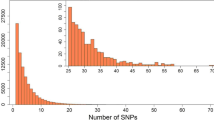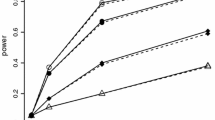Abstract
Association analysis in important crop species has generated heightened interest for its potential in dissecting complex traits by utilizing diverse mapping populations. However, the mixed linear model approach is currently limited to single marker analysis, which is not suitable for studying multiple QTL effects, epistasis and gene by environment interactions. In this paper, we propose the adaptive mixed LASSO method that can incorporate a large number of predictors (genetic markers, epistatic effects, environmental covariates, and gene by environment interactions) while simultaneously accounting for the population structure. We show that the adaptive mixed LASSO estimator possesses the oracle property of adaptive LASSO. Algorithms are developed to iteratively estimate the regression coefficients and variance components. Our results demonstrate that the adaptive mixed LASSO method is very promising in modeling multiple genetic effects when a large number of markers are available and the population structure cannot be ignored. It is expected to be a powerful tool for studying the architecture of complex traits in important plant species. Supplemental materials for this article are available from the journal website.
Similar content being viewed by others
References
Akbari, M., Wenzl, P., Caig, V., Carling, J., Xia, L., Yang, S., Uszynski, G., Mohler, V., Lehmensiek, A., Kuchel, H., Hayden, M. J., Howes, N., Sharp, P., Vaughan, P., Rathmell, B., Huttner, E., and Kilian, A. (2006), “Diversity Arrays Technology (DArT) for High-throughput Profiling of the Hexaploid Wheat Genome,” Theoretical and Applied Genetics, 113, 1409–1420.
Ball, R. D. (2001), “Bayesian Methods for Quantitative Trait Loci Mapping Based on Model Selection: Approximate Analysis Using the Bayesian Information Criterion,” Genetics, 159, 1351–1364.
Bondell, H. D., Krishna, A., and Ghosh, S. K. (2010), “Joint Variable Selection for Fixed and Random Effects in Linear Mixed-Effects Models,” Biometrics, doi:10.1111/j.1541-0420.2010.01391.x.
Broman, K. W., and Speed, T. P. (2002), “A Model Selection Approach for the Identification of Quantitative Trait Loci in Experimental Crosses,” Journal of the Royal Statistical Society Series B, 64, 641–656.
Chen, J., and Chen, Z. (2008), “Extended Bayesian Information Criterion for Model Selection with Large Model Spaces,” Biometrika, 95, 759–771.
Crossa, J., Burgueno, J., Dreisigacker, S., Vargas, M., Herrera-Foessel, S. A., Lillemo, M., Singh, R. P., Trethowan, R., Warburton, M., Franco, J., Reynolds, M., Crouch, J. H., and Ortiz, R. (2007), “Association Analysis of Historical Bread Wheat Germplasm Using Additive Genetic Covariance of Relatives and Population Structure,” Genetics, 177, 1889–1913.
de los Campos, G., Naya, H., Gianola, D., Crossa, J., Legarra, A., Manfredi, E., Weigel, K., and Cotes, J. M. (2009), “Predicting Quantitative Traits with Regression Models for Dense Molecular Markers and Pedigree,” Genetics, 182, 375–385.
Devlin, B., and Roeder, K. (1999), “Genomic Control for Association Studies,” Biometrics, 55, 997–1004.
Dudley, J. W. (2008), “Epistatic Interactions in Crosses of Illinois High Oil x Illinois Low Oil and of Illinois High Protein x Illinois Oil Protein Corn Strains,” Crop Science, 48, 59–68.
Efron, B., Hastie, T., Johnstone, I., and Tibshirani, R. (2004), “Least Angle Regression,” Annals of Statistics, 32, 407–499.
Fan, J., and Lv, J. (2008), “Sure Independence Screening for Ultra-High Dimensional Feature Space” (with discussion), Journal of the Royal Statistical Society Series B, 70, 849–911.
Foster, S. D., Verbyla, A. P., and Pitchford, W. S. (2007), “Incorporating LASSO Effects into a Mixed Model for Quantitative Trait Loci Detection,” Journal of Agricultural, Biological, and Environmental Statistics, 12, 300–314.
Friedman, J., Hastie, T., Hoefling, H., and Tibshirani, R. (2007), “Pathwise Coordinate Optimization,” Annals of Applied Statistics, 1, 302–332.
Hastie, T., Tibshirani, R., and Friedman, J. (2009), The Elements of Statistical Learning: Data Mining, Inference, and Prediction (2nd ed.), New York: Springer.
Ibrahim, J. G., Zhu, H., Garcia, R. I., and Guo, R. (2010), “Fixed and Random Effects Selection in Mixed Effects Models,” Biometrics, doi:10.1111/j.1541-0420.2010.01463.x.
Jansen, R. C. (1993), “Interval Mapping of Multiple Quantitative Trait Loci,” Genetics, 135, 205–211.
Jansen, R. C., and Stam, P. (1994), “High Resolution of Quantitative Traits into Multiple Loci via Interval Mapping,” Genetics, 136, 1447–1455.
Kang, H. M., Zaitlen, N. A., Wade, C. M., Kirby, A., Heckerman, D., Daly, M. J., and Eskin, E. (2008), “Efficient Control of Population Structure in Model Organism Association Mapping,” Genetics, 178, 1709–1723.
Kao, C.-H., Zeng, Z.-B., and Teasdale, R. D. (1999), “Multiple Interval Mapping for Quantitative Trait Loci,” Genetics, 152, 1203–1216.
Meuwissen, T. H. E., Hayes, B. J., and Goddard, M. E. (2001), “Prediction of Total Genetic Value Using Genome-Wide Dense Marker Maps,” Genetics, 157, 1819–1829.
Park, T., and Casella, G. (2008), “The Bayesian LASSO,” Journal of the American Statistical Association, 103, 681–686.
Price, A. L., Patterson, N. J., Plenge, R. M., Weinblatt, M. E., Shadick, N. A., and Reich, D. (2006), “Principal Components Analysis Corrects for Stratification in Genome-Wide Association Studies,” Nature Genetics, 38, 904–909.
Pritchard, J. K., Stephens, M., and Donnelly, P. (2000), “Inference of Population Structure Using Multilocus Genotype Data,” Genetics, 155, 945–959.
Stich, B., Möhring, J., Piepho, H. P., Heckenberger, M., Buckler, E. S., and Melchinger, A. E. (2008), “Comparison of Mixed-Model Approaches for Association Mapping,” Genetics, 178, 1745–1754.
Tibshirani, R. (1996), “Regression Shrinkage and Selection via the Lasso,” Journal of the Royal Statistical Society Series B, 58, 267–288.
Tibshirani, R., Saunders, M., Rosset, S., Zhu, J., and Knight, K. (2005), “Sparsity and Smoothness via the Fused Lasso,” Journal of the Royal Statistical Society Series B, 67, 91–108.
Tibshirani, R., and Wang, P. (2008), “Spatial Smoothing and Hot Spot Detection for CGH Data Using the Fused Lasso,” Biostatistics, 9, 18–29.
Varshney, R. K., and Tuberosa, R. (2007), “Genomics-Assisted Crop Improvement: An Overview,” in Genomics-Assisted Crop Improvement, eds. R.K. Varshney and R. Ruberosa, Dordrecht, the Netherlands: Springer, pp. 1–12.
Wang, H., Zhang, Y.-M., Li, X., Masinde, G. L., Mohan, S., Baylink, D. J., and Xu, S. (2005), “Bayesian Shrinkage Estimation of Quantitative Trait Loci Parameters,” Genetics, 170, 465–480.
Wu, T. T., Chen, Y. F., Hastie, T., Sobel, E., and Lange, K. (2009), “Genome-Wide Association Analysis by Lasso Penalized Logistic Regression,” Bioinformatics, 25, 714–721.
Xu, S. (2003), “Estimating Polygenetic Effects Using Markers of the Entire Genome,” Genetics, 163, 789–801.
— (2007), “An Empirical Bayes Method for Estimating Epistatic Effects of Quantitative Trait Loci,” Biometrics, 63, 513–521.
Xu, S., and Jia, Z. (2007), “Genomewide Analysis of Epistatic Effects for Quantitative Traits in Barley,” Genetics, 175, 1955–1963.
Xu, Y., and Crouch, J. H. (2008), “Marker-Assisted Selection in Plant Breeding: From Publications to Practice,” Crop Science, 48, 391–407.
Yi, N., and Xu, S. (2008), “Bayesian LASSO for Quantitative Trait Loci Mapping,” Genetics, 179, 1045–1055.
Yu, J., Pressoir, G., Briggs, W. H., Vroh Bi, I., Yamasaki, M., Doebley, J. F., McMullen, M. D., Gaut, B. S., Nielsen, D. M., Holland, J. B., Kresovich, S., and Buckler, E. S. (2006), “A Unified Mixed-Model Method for Association Mapping that Accounts for Multiple Levels of Relatedness,” Nature Genetics, 38, 203–208.
Zeng, Z.-B. (1994), “Precision Mapping of Quantitative Trait Loci,” Genetics, 136, 1457–1468.
Zhang, H., and Lu, W. (2007), “Adaptive LASSO for Cox’s Proportional Hazards Model in Survival Analysis,” Statistics in Medicine, 11, 1871–1879.
Zhao, K., Aranzana, M. J., Kim, S., Lister, C., Shindo, C., Tang, C., Toomajian, C., Zheng, H., Dean, C., Marjoram, P., and Nordborg, M. (2007), “An Arabidopsis Example of Association Mapping in Structured Samples,” PLoS Genetics, 3, e4.
Zhu, C., and Yu, J. (2009), “Nonmetric Multidimensional Scaling Corrects for Population Structure in Association Mapping with Different Sample Types,” Genetics, 182, 875–888.
Zou, H. (2006), “The Adaptive LASSO and its Oracle Properties,” Journal of the American Statistical Association, 101, 1418–1429.
Author information
Authors and Affiliations
Corresponding author
Electronic Supplementary Material
Below is the link to the electronic supplementary material.
Rights and permissions
About this article
Cite this article
Wang, D., Eskridge, K.M. & Crossa, J. Identifying QTLs and Epistasis in Structured Plant Populations Using Adaptive Mixed LASSO. JABES 16, 170–184 (2011). https://doi.org/10.1007/s13253-010-0046-2
Accepted:
Published:
Issue Date:
DOI: https://doi.org/10.1007/s13253-010-0046-2




